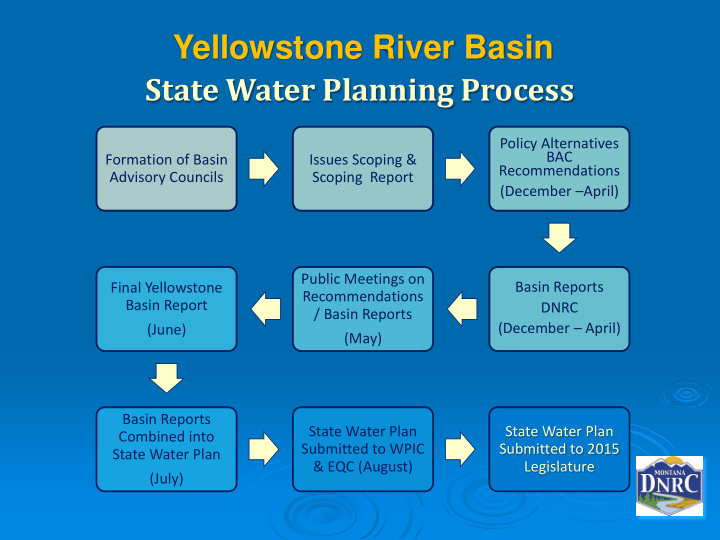



Yellowstone River Basin State Water Planning Process Policy Alternatives BAC Formation of Basin Issues Scoping & Recommendations Advisory Councils Scoping Report (December –April) Public Meetings on Basin Reports Final Yellowstone Recommendations Basin Report DNRC / Basin Reports (December – April) (June) (May) Basin Reports State Water Plan State Water Plan Combined into Submitted to WPIC Submitted to 2015 State Water Plan & EQC (August) Legislature (July)
Yellowstone River Basin Statutory direction for State Water Plan Inventory of Consumptive and Non- Consumptive Uses associated with W/R Estimates of water to satisfy future demands Analysis of effects of drought and depletions of water availability Proposals to satisfy existing W/R and new demands Legislation necessary to address water resource concerns in the basin
Yellowstone River Basin State Water Planning Process Phase 1: Form Basin Advisory Councils (BAC’s) Conduct issues scoping through public listening sessions. Prioritize issues of concern. Phase 2: Development of policy alternatives based upon issues scoping and data collection effort. Establish criteria for screening alternatives. Phase 3: BAC / DNRC work together to develop policy recommendations and implementation strategy for presentation to WPIC, EQC and 2015 Legislature. Publish final report.
Yellowstone River Basin Phase 3 - Plan Recommendations BAC develops policy and or budgetary recommendations for Yellowstone Basin Recommendations Report DNRC prepares final State Water Plan and budget requests using input from 4 Basin Advisory Councils Legislative/policy recommendations for changes in state law. Budget requests for plan implementation
Yellowstone River Basin Screening criteria can be used to whittle down the list of alternatives to those that can actually implemented. Issue Potential Criteria for Screening Alternatives: 1. Is it technically feasible Alternatives 2. Is it politically feasible 3. Is it financially feasible 4. Is it socially acceptable 5. Does it require statute change? Criteria 6. Does it apply to the whole basin? Recommendations
Yellowstone River Basin Table 7: Yellowstone BAC Preliminary Rankings of Issues Identified by the Public Calculated # with this # who ranked CONCERN Score* as #1 Rank this as 1-7 1220 Availability 10 13 840 Drought Readiness 1 11 550 Enforcement/Protecting Senior Rights 1 7 550 Water Quality 1 7 350 Instream Flows 0 6 Shifting Practices: Irrigation 340 Technologies 0 6 310 Future Allocations/Additional Rights 0 5 Incentives and Support for New 310 Technologies and Conservation 0 5 300 Storage Capacities 0 5 280 Reservations (Protected MT Rights) 0 4 250 Current Allocations 1 4 250 Planning 0 4 240 Beneficial Uses 1 3 230 Montana as Priority 1 3 220 Gauges/Monitoring 0 4 210 Municipal Needs, Urban Dev & Pop 0 3 190 Shifting Practices: Water to Industry 0 4 190 Water Market Transfers 1 3 160 Hydrologic Model –Variability 0 2 160 Hydrologic Model—Full Development 0 3 140 Recreational Uses 0 2 100 Exempt Wells/Groundwater Wells 0 2 90 Fisheries and Wildlife 0 1 80 Invasive Species 0 2 80 Stock Ponds and Tanks/Fishing Ponds 0 1 70 Use It or Lose It Principle 0 1 60 Hydraulic Fracturing (Fracking) 0 1 50 Tribal (Reserved) Rights 0 1
Yellowstone River Basin The Yellowstone River basin planning process is guided by the following concepts: 1. delivery of information that is sufficient to understand the water resources and the current and prospective demands placed on those resources, and enable sound water use decision-making by water users and prospective users, 2. strengthening the existing water allocation system to optimize present use and establish need for future water availability under the existing doctrines of prior appropriation and beneficial use, and 3. enabling water users to achieve fairness under the law and these same doctrines, in water allocation among senior and junior water right owners during times of scarcity (drought).
Yellowstone River Basin Water Plan Development Schedule 2014 February 15 – Completion of 50% Draft April 1 – Completion of 75% Draft May 30 – MWSI Phase 3 Complete July 15 – Complete Draft of Basin Reports - Water Resources Administrator August 1 – Complete Draft - DNRC Director August 15 – Complete Draft – WPIC / EQC
Yellowstone River Basin Phase 2 – Technical Transfer / Alternatives Development Collect input from experts to inform and educate group on priority issues BAC needs to decide which issues it needs additional input on. DNRC provides input on current consumptive use estimates, future demands, analysis of impacts of increased drought, climate change
Yellowstone River Basin Advisory Council Work Plan Phases 2 and 3 Four meetings December – April Develop framework and criteria for options to address priority issues Complete recommendations, rationale, and implementation plan for all priority issues Preparation of Final Recommendations Report Outreach to Inform Public / Decision Makers of Recommendations of State Water Plan
Yellowstone River Basin Plan Format and Public Hearings Separate Basin Plans for Clark Fork/Kootenai, Upper Missouri, Lower Missouri, Yellowstone River Basins Department shall hold a hearing or hearings in the state or in an area of the state encompassed by plan Statewide summary document containing individual basin plan summaries and water planning recommendations
Recommend
More recommend